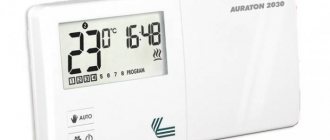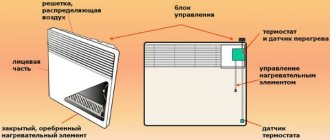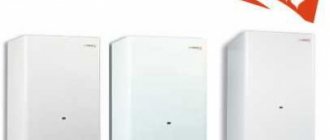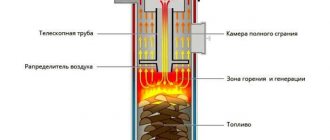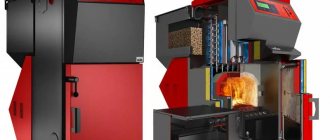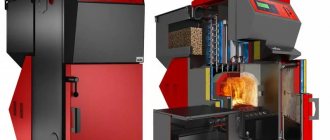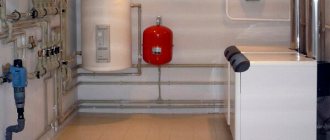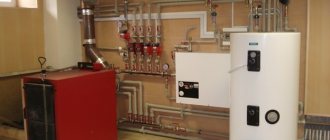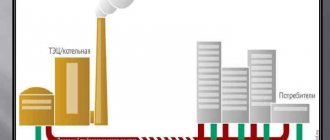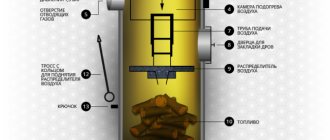“Buying an electric boiler is not profitable.” This myth is refuted by the fact that manufacturers are releasing more and more models of different configurations to suit any consumer request. In the absence of an alternative, heating with electricity becomes a profitable solution. You just need to choose the equipment correctly, install it correctly, and adjust the work. Let's talk about it here. And again, we will build on your wishes.
Why is an electric heating boiler better than a gas one?
Despite the fact that gas is a cheaper source of energy than electricity, installing gas equipment is not always preferable. The main obstacles to installing a boiler of this type are:
- Difficulties with obtaining permission, coordination and preparation for installation. The room must have a properly organized ventilation system and removal of combustion products.
- High cost of equipment and labor intensive installation. And if we are talking about a private house where gas is not supplied, then the costs increase significantly.
- Potential danger of the fuel itself and its combustion products.
Advantages of electric heating systems
Electric boilers have many advantages, including:
- High reliability in terms of fire safety (of course, subject to the availability of high-quality wiring and fuses).
- Low installation costs, easy installation.
- Wide price range, choice of functions. In general, electric models are cheaper than gas models. You can choose a simple boiler, consisting of a set of heating elements and a primitive control system, which will cost very little. If there are no financial restrictions, you should pay attention to automated devices. They are able to maintain a given temperature with minimal energy consumption and have several programming modes, a GSM controller that allows you to regulate the operation of the device from a distance, and other useful options.
- Compact and aesthetically pleasing. In many modern models, all the necessary elements - a circulation pump, an expansion tank, an air vent, protection systems - are hidden inside the housing. If desired, the electric boiler can be installed in any room of the apartment. The most common are wall-mounted varieties.
- Ease of use. To control the device you only need to press a few buttons. Electric boilers do not require control or participation in their operation.
- Silence. The owners can only hear the quiet hum of the induction device or the hum of the automation units.
- There is no need for coordination with relevant organizations when the device power does not exceed 9 kilowatts.
- High efficiency.
Types of heaters for direct electric heating of the house
Since the key elements for any direct electric heating systems are heaters, it is necessary to get at least a little familiar with the devices on our market.
This equipment is classified according to several criteria, the main one being the heat transfer method.
For example, radiant and convective heaters.
Radiant heaters include infrared panels and mirrors that emit heat.
And devices whose operation is based on convection are electric convectors, air heaters and heat fans.
To those listed above should be added the following types of heaters - combined, convective-radiation, as well as electric heaters, the operation of which is based on “indirect heating”.
Disadvantages and difficulties of operating electric boilers
The advantages of electric boilers look very attractive. But they also have disadvantages, and very significant ones.
- High cost of electricity.
Note! Costs can be reduced several times by insulating the apartment, using preferential electricity tariffs and choosing a device with precise adjustment.
- Requirements for the type of radiators. In an electrically heated system, it is uneconomical to use cast iron and steel batteries. It is advisable to choose bimetallic or, as a last resort, aluminum heating devices.
- Complete dependence on power supply.
- Demanding on the quality and composition of the coolant.
- When installing equipment that consumes more than 9 kW, instead of a standard 220 V network, a three-phase 380 V network will be required. If the apartment does not have one, you must obtain a special permit for the installation, which is not always possible in old houses.
Before you decide to purchase and install an electric boiler, you need to weigh all the pros and cons, calculate the approximate electricity consumption per month and think about how significant it will be for the budget.
Using double tariff
When using an electric boiler as the main source of thermal energy, you can save on bills by installing a two-tariff meter.
There is a special electricity metering system in which at night the tariffs for electricity consumption are reduced (up to 4 times). This is a good way to reduce costs, but you will have to slightly change the operating mode of the boiler.
At night, water is heated, which maintains its temperature while in a thermally insulated container. During the day, hot water is used for household needs, and at night its supply is replenished again.
It is necessary to take into account that this option is only good for double-circuit boilers that simultaneously heat both the coolant and hot water. For single-circuit models, this method gives too little effect, and given the high cost of the meter, there may be no savings at all. In addition, tariffs differ in different regions, therefore, before deciding to use a two-tariff meter, it is necessary to calculate the possible savings and decide whether this idea makes any sense.
Electric boilers with heating elements (tubular heaters)
Such boilers work on the same principle as most household electrical appliances - kettles, boilers, irons. They are most in demand among consumers and are presented in a wide variety of models. There can be several heating elements, and they are turned on together or alternately.
Pros:
- simplicity of design;
- reliability of the circuit, ease of repair.
Minuses:
- high inertia of boilers - slow heating at startup;
- demands on the quality of the coolant. The tendency for scale to form, which reduces heating efficiency, forces special measures to be taken. You can install anode rods that will collect salt deposits on themselves, and change them at certain intervals, just like the heating elements themselves. But it is better to use specially prepared water or a special coolant.
Induction devices
Induction boilers are energy-efficient and reliable devices that can operate for years without maintenance or repair.
Pros:
- thanks to the phenomenon of self-induction, they significantly save energy (up to 30% during the heating season);
- undemanding to the composition of the coolant (scale does not appear in such boilers);
- service life - from 30 years, the likelihood of breakdown due to the design features is very low;
- quick heating of the coolant;
- possibility of precise adjustment.
Minuses:
- large mass (from 30 kg) - strong brackets are used for hanging, the wall must be able to withstand the load;
- circulation pump, expansion tank, safety group are purchased and installed separately;
- relatively high cost;
- vibration noise during operation.
Ionic (electrode) heating boilers
Such devices heat the coolant by applying voltage through the electrodes, resulting in the ionization of molecules and their movement towards a conductor with a different polarity. In a single-phase network, one electrode is used in the form of a rod, the second is the surface of a metal cylinder, with three-phase voltage - 3 electrodes.
The sizes of ion boilers vary from very small ones, capable of heating only one battery, to large installations designed for a large house. Available both with and without casing.
Pros:
- compactness. The device without a housing takes up little space;
- high-speed heating of the coolant;
- low inertia, allowing very precise adjustment;
- resistance to voltage surges;
- high level of safety - if there is no coolant in the boiler, it simply cannot work;
- low price (without control unit, pump and expansion tank).
Minuses:
- complete incompatibility with batteries made of steel and cast iron;
- demands on the quality of the circulating fluid, which must have a balanced composition. It is recommended not to make it yourself, but to purchase a ready-made one;
- the need for a specialist to check the condition of the coolant before the new heating season;
- special requirements for the grounding loop;
- heating temperature – no higher than 75 °C;
- the need to replace electrodes at certain intervals.
Design features
A double-circuit heating boiler has a simple design, although it performs the function of a mini-boiler room. Both of its circuits can work either individually or in pairs, heating the house and providing hot water at the same time. The equipment in question consists of the following components:
- heat exchanger;
- boiler;
- heating elements;
- expansion tank;
- circulation pump;
- air vent;
- safety valve;
- automation;
- control unit.
Electric double-circuit models differ from single-circuit models by the presence of a built-in boiler in the design.
In appearance and main design features, electric boiler models can be:
- wall-mounted – compact and relatively light;
- floor-mounted – massive, with a high power rating (more than 60 kW).
As the name implies, heating equipment of the first group is mounted on walls or on specially installed metal frames. The second group of boilers is placed directly on the floor in a specially designated area. It should be noted that modern electric boilers are quite aesthetic and in no way can spoil the interior of the room.
According to the heating method, they can be divided into three groups:
- Heating elements - highly reliable, having one or more heating elements in the form of a metal tube inside the container;
- electrode (or ionic) – heating the coolant as it passes through a liquid alternating current medium. They have the ability to switch off independently in the event of a short circuit, a maximum increase in temperature and a decrease in the volume of water to a critical value;
- induction - operating thanks to inductance coils. Refers to energy-saving devices.
The first option refers to indirect heating of the coolant, and the second is considered as direct heating.
In terms of power, electric boilers intended for heating needs can be:
- single-phase (up to 12 kW);
- three-phase (more than 12 kW).
It is recommended to select power with the help of specialists, since only they can make a competent calculation. The method of selecting a boiler based on the area of the house is incorrect, since in addition to this parameter, a number of others are also taken into account (wall thickness, number of openings, orientation to the cardinal points, etc.).
As a rule, household heating units operate from a 220V network.
Single-circuit and double-circuit boilers: what is the difference?
Let's look at the differences between the two modifications of these units.
- Single-circuit boilers are designed only for heating the room. At the same time, an indirect heating boiler can be connected to all modern boilers and hot water supply can be provided.
- Double-circuit, in addition to participating in the heating system, heat water for domestic needs. Their design provides an additional heat exchanger, which can be flow-through or storage - in the form of a built-in water heating tank.
Note! A double-circuit boiler cannot operate on 2 circuits at the same time. When you open a hot water tap, heating of the heating fluid stops.
Let us briefly describe their advantages and disadvantages.
Advantages of a single-circuit boiler:
- relatively low cost;
- high efficiency and high power;
- lower energy consumption (no boiler).
Minuses:
- if necessary, you will have to install an additional boiler to heat water;
- together with an indirect heating boiler, the design looks bulky and unaesthetic.
Advantages of a dual-circuit device:
- quite compact size;
- easy installation.
Minuses:
- instability of water pressure and temperature;
- high requirements for coolant quality and maintenance;
- high cost.
Note! If we compare the prices of a double-circuit boiler and a device with one circuit and an additional boiler, the first will cost less.
It's difficult to say which boiler is better. If it is important to save energy, as well as space in the apartment, you should choose a double-circuit version. This device heats water only when it is needed; the single-circuit device will turn on every time the liquid cools down. At the same time, a single-circuit boiler is considered more reliable and convenient to use.
Advice. If your automated boiler has an additional storage tank, it can be programmed to heat water at night when electricity rates are lower. During the day, when the cost of electricity is higher, you can use already heated water.
Installation procedures
To hang the device, you need a mounting plate, which is included in the delivery package: it is attached to the wall with four dowels or anchor bolts with mandatory horizontal and vertical alignment. If this is a floor-standing boiler, then it is installed on a special stand.
The device must be grounded, inspected and made sure that it is in the correct position, the water pressure in the system is normal, and all communications are connected.
Electric heating units must be connected with a wire whose cross-section is indicated in the documentation for the equipment. Wires are carried in special protective boxes.
Scheme options
There are various diagrams: a diagram for connecting an electric boiler with heating radiators, diagrams with the possibility of installing a cascade. The latter option is used if it is necessary to heat large areas. To operate devices in a cascade, the terminals of the control unit are connected to the terminals of the controlled unit. If the installation system is controlled by a room regulator, then its control contacts are connected to the terminals of the leading equipment.
Heating apparatus piping
Tying can be carried out using a direct or mixing scheme. The direct scheme involves adjusting the temperatures with a burner, the mixing scheme involves a mixer with a servo drive. The binding is carried out as follows. The boiler manifold is installed, a pipe of the required diameter is connected to the boiler.
A three-way mixing valve is installed at the inlet, which will regulate the temperature. A circulation pump is installed on the return line and a control unit is mounted. After piping, you can fill the system with coolant and test the operation of the equipment for correctness.
Do not underestimate this stage: in reality, it is not as simple and insignificant as it might seem. Normal piping allows you to use equipment without an automation system, and this greatly reduces costs. Therefore, it must be performed at a professional level and taking into account the design features of the system and boiler.
The wiring of an electric boiler must be done by a specialist. If you still have to do it yourself, then you need already assembled distribution units. General diagram of the implementation of a heating system in a house.
Power
The power of the boiler is its most important characteristic, which means you need to choose it correctly. Sometimes it is tied to the footage and calculated based on the value of 1 kW per 10 m2. This formula is only suitable for a very rough estimate.
In fact, you need to focus on heat loss. If, for example, they are 8 kW, then you need a boiler of the same power. The calculations take into account:
- area and height of the room;
- degree of insulation of walls, floors, ceilings;
- the number of external walls and their location according to the cardinal directions;
- number, dimensions and type of windows;
- battery connection diagram;
- region of residence and other parameters.
To correctly calculate the boiler power, it is recommended to use special calculators or seek advice from a heating engineer.
Energy savings
Running an electric boiler will consume energy, for which you have to pay and the prices for which are constantly rising. In order not to waste your finances, it is recommended to carry out work to reduce heat loss, which can occur through cracks in wooden windows, single-glazed windows in metal-plastic structures, uninsulated ceilings or ceilings between floors, roofs not sealed with insulation, as well as the floor.
For insulation, you can use inexpensive materials - mineral wool, polyethylene foam, polyurethane foam.
Additional functions
The following functions of electric boilers may be useful:
- protection systems – from overheating, short circuit, overpressure;
- the ability to install a GSM controller, which will allow you to remotely adjust the temperature in the apartment, change the boiler settings, and send notifications about possible problems;
- a control unit with energy-saving modes that allow you to reduce the temperature at certain periods of time - at night, when residents are not at home;
- smooth power adjustment. This option is more convenient and profitable than the stepped one.
Note! Often control units are not included in the package of electric boilers. In this case, they will have to be purchased separately.
How to choose
What kind of heating boiler is installed in your house?
ElectricGas
The main task is to determine the power of the unit. To obtain the most accurate calculation, you will have to determine the heat loss of the room, take into account the material of the walls, the height of the ceilings, the configuration of the house and other factors. This is an extremely difficult task, which only trained and experienced specialists undertake.
When choosing a boiler, they follow a simple and fairly accurate method. It is generally accepted that 1 kW of boiler power is needed to heat an area of 10 m2. Based on this ratio, a simple and quick calculation is made. Take the total area of the house and divide it by 10. The resulting number will be the optimal power of the heating unit.
It is recommended to make a small power reserve to compensate for heat loss resulting from power surges. In addition, if you need a double-circuit boiler, the power must be increased by 25%.
Expert opinion
Torsunov Pavel Maksimovich
The use of an electric boiler to heat a private home is relatively rare. Users are confident of high energy costs and also doubt the readiness of power grids to handle such a load. These fears are well founded, especially in remote villages with excess load.
Reliability, safety and the absence of the need to control electric boilers make them the most reliable and simple devices. It becomes possible to install it in any convenient place in the house (but not on the street), there is no need to build a chimney, installation and maintenance are simplified. These advantages force many users to put up with the disadvantages of such heaters and choose them for use as the main source of thermal energy.
Popular models
Among the variety of brands, the leading positions in the ranking are occupied by the following manufacturers:
- Protherm (Slovakia),
- Vaillant (Germany),
- Kospel (Poland),
- Buderus (Germany).
Among Russian brands, buyers give preference to 3 brands:
- "EVAN"
- ZOTA,
- "RusNIT".
The best models from the category of medium-power boilers that are suitable for apartments, based on user reviews:
- RusNit 208M (average price - 16 thousand rubles);
- EVAN Warmos-IV-5 (16.5 thousand rubles);
- ZOTA 12 Lux (RUB 21.4 thousand);
- Kospel EKCO L2 12 (37 thousand rubles);
- Protherm Skat 12 KR 13 (32.5 thousand rubles);
- Vaillant eloBLOCK VE 12 (35 thousand rubles);
- Buderus Logamax E213-10 (9.3 thousand rubles).

